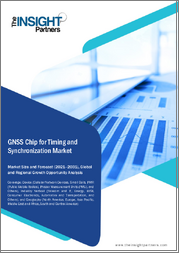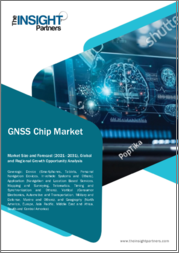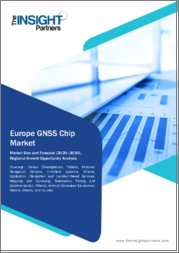
|
시장보고서
상품코드
1783681
GNSS 내비게이션 모듈 시장 보고서 : 동향, 예측, 경쟁 분석(-2031년)GNSS Navigation Module Market Report: Trends, Forecast and Competitive Analysis to 2031 |
||||||
세계의 GNSS 내비게이션 모듈 시장 미래는 지능형 운송, 무인 항공기 및 로봇, 소비자용 전자 기기, 산업용 모니터링 시장에 기회가 있을 것입니다. 세계의 GNSS 내비게이션 모듈 시장은 2025-2031년에 걸쳐 CAGR 4.5%를 나타낼 것으로 예측됩니다. 이 시장의 주요 촉진요인은 위치 정보 서비스 수요 증가, 자동차 용도에서의 사용 증가, 스마트 장치에서의 채용 확대입니다.
- Lucintel의 예측에 따르면, 유형별로는 다중 주파수가 예측 기간 동안 가장 높은 성장을 이룰 전망입니다.
- 용도별로는 드론과 로보틱스가 가장 높은 성장이 예상됩니다.
- 지역별로는 아시아태평양이 예측기간에서 가장 높은 성장이 예상됩니다.
150페이지 이상의 종합적인 보고서를 통해 비즈니스 의사 결정에 도움이 되는 귀중한 인사이트를 얻을 수 있습니다. 몇 가지 인사이트를 포함하는 샘플 다이어그램이 아래에 나와 있습니다.
GNSS 내비게이션 모듈 시장 새로운 동향
GNSS 내비게이션 모듈 시장은 기술적 전면과 응용 분야에 영향을 미치는 많은 신흥 동향에 직면하고 있습니다. 이러한 새로운 동향은 여러 산업에서의 측위의 정확성과 신뢰성에 대한 요구 증가에 영향을 받고 있습니다.
- RTK와 PPP에 의한 고정밀 GNSS : GNSS 모듈에 실시간 운동학(RTK)과 고정밀 포인트 포지셔닝(PPP) 기술을 구현하는 경향이 강해져, 센티미터 레벨의 정밀도를 달성하는 것이 현실감을 띠고 있습니다. 이러한 고정밀도는 자율주행차, 정밀농업, 측량, 무인항공기 내비게이션에 필수적이며 보다 복잡하고 고정밀 GNSS 솔루션의 개발을 촉진하고 있습니다.
- 다중 주파수 GNSS 수신기 : 다중 주파수 GNSS 수신기의 사용은 증가하는 경향이 있습니다. 다중 주파수 대역에서 신호를 수신하면 이러한 수신기는 전리층과 대류권의 오차를 제거하는 데 뛰어나 정확도가 향상되며 특히 악조건에서 수렴 시간이 단축됩니다. 이 추세는 안전 중요 용도과 같은 포지셔닝 무결성이 요구되는 용도에 매우 중요합니다.
- 보다 높은 정밀도와 신뢰성을 위한 센서 퓨전 : GNSS와 관성 측정 유닛(IMU), 휠 속도 센서, 비전 시스템과의 융합은 점점 널리 사용되고 있습니다. 센서 퓨전 알고리즘은 이러한 소스로부터의 정보를 혼합하여, 특히 터널이나 도시 지역의 협곡과 같은 GNSS를 사용할 수 없는 지역에서 보다 강력하고 지속적인 위치 결정을 제공하며, 내비게이션의 신뢰성을 높입니다.
- 저소비 전력 및 소형화 : GNSS 모듈의 소형화, 저소비 전력화가 진행되고 있습니다. 이것은 크기와 전력이 큰 제약이 되는 배터리 구동 장치, 웨어러블, 임베디드 용도에 필수적입니다. 칩 설계와 제조 공정의 발전으로 고도로 통합된 전력 효율적인 GNSS 솔루션을 생산할 수 있습니다.
- 재밍 및 스푸핑에 대한 보안 기능 향상 : 안전하고 중요한 용도에서 GNSS에 대한 의존도가 높아짐에 따라 스푸핑 및 재밍과 같은 악의적인 간섭에 대한 보안이 최우선 과제가 되었습니다. 향후의 동향으로서는 보다 세련된 신호 처리 알고리즘, 암호화 기술, 멀티 안테나 구조 등을 통합해, 이러한 위협을 검지·경감하는 것으로, GNSS 베이스의 내비게이션의 완전성과 신뢰성을 제공하는 방향으로 향하고 있습니다.
이러한 새로운 동향은 정확성, 신뢰성 및 보안을 향상시켜 GNSS 내비게이션 모듈 시장을 재정의하려고 합니다. 고정밀 기술, 다중 주파수 수신기, 센서 퓨전, 소형화 및 고급 보안 기능의 조합은 용도의 잠재력을 넓혀 GNSS를 보다 탄력적이고 신뢰할 수 있는 포지셔닝 솔루션으로 산업 전체에 침투시킵니다.
GNSS 내비게이션 모듈 시장 최근 동향
GNSS 내비게이션 모듈 시장은 정확성, 신뢰성, 통합성 향상에 중점을 두었고, 지난 몇 년 동안 다양한 주목할만한 진보를 보였습니다.
- 다중 별자리 및 다중 주파수 모듈의 가용성 : 가장 주목할만한 개발 중 하나는 여러 위성 별자리(GPS, GLONASS, Galileo, Bei Dou, Nav IC, QZSS)와 여러 주파수 대역을 동시에 추적할 수 있는 GNSS 모듈을 전반적으로 사용할 수 있다는 것입니다. 이렇게 하면 측위 정확도가 크게 향상되고 첫 번째 측위까지의 시간이 단축되고 엄격한 신호 조건 하에서 신뢰성이 향상됩니다.
- GNSS 모듈에 밀접하게 결합된 관성 측정 장치(IMU) 통합 : 최신 GNSS 모듈 중 일부는 저전력, 고성능 IMU를 밀접하게 결합합니다. 이 센서 퓨전의 단일 모듈 밀접한 결합은 GNSS 정지 중 추측 항법과 도시 지역의 협곡, 터널 및 실내 공간에서보다 지속적이고 부드러운 내비게이션을 가능하게합니다.
- 실시간 역학 및 고정밀 포인트 포지셔닝 지원을 위한 모듈 개발 : 최근의 동향으로서 RTK와 PPP를 지원하는 작고 저비용 GNSS 모듈의 개발이 진행되고 있습니다. 이러한 기능은 센티미터 수준의 포지셔닝을 가능하게 하며 자율 주행 차량, 정밀 농업, 측량과 같은 고정밀도가 필요한 용도에 새로운 문을 엽니다.
- 안티-스푸핑 및 안티-재밍 기술의 진보 : GNSS의 취약성에 주목을 받고 있는 동안, 새로운 모듈은 스푸핑과 재밍을 감지하고 차단하는 최첨단 신호 처리 기술과 알고리즘을 도입하여 안전 중요 용도에서 점점 더 중요해지고 있는 무결성 공격으로부터 보호를 제공합니다.
- 소형화와 시스템 온칩 통합 : GNSS 솔루션의 소형화, 통합화 방향은 계속되고 있습니다. 최근의 동향에서는 GNSS 수신기를 Bluetooth, Wi-Fi, 셀룰러 연결 등의 다른 기능과 함께 하나의 시스템 온칩에 통합함으로써 많은 IoT 및 모바일 애플리케이션를 위한 전체 솔루션의 크기, 전력 소비 및 비용을 최소화합니다.
멀티 컨스텔레이션 및 다중 주파수 기능, IMU 통합, RTK/PPP 기능, 고급 보안 기능, SoC 통합을 통한 소형화 등 GNSS 내비게이션 모듈 시장의 이러한 새로운 진보는 보다 정확하고 신뢰성 있고 안전하며 다목적 측위 솔루션으로 폭넓은 용도에 누적적으로 영향을 미치고 있습니다.
목차
제1장 주요 요약
제2장 세계의 GNSS 내비게이션 모듈 시장 : 시장 역학
- 서론, 배경, 분류
- 공급망
- PESTLE 분석
- 특허 분석
- 규제 환경
- 업계의 성장 촉진요인과 과제
제3장 시장 동향과 예측 분석(2019-2031년)
- 거시 경제 동향(2019-2024년)과 예측(2025-2031년)
- 세계의 GNSS 내비게이션 모듈 시장 동향(2019-2024년)과 예측(2025-2031년)
- 유형별
- 단일 주파수 : 동향과 예측(2019-2031년)
- 이중 주파수 : 동향과 예측(2019-2031년)
- 다중 주파수 : 동향과 예측(2019-2031년)
- 용도별
- 지능형 교통 : 동향과 예측(2019-2031년)
- 드론 및 로봇공학 : 동향과 예측(2019-2031년)
- 소비자 가전 : 동향과 예측(2019-2031년)
- 산업 모니터링 : 동향과 예측(2019-2031년)
- 기타 : 동향과 예측(2019-2031년)
제4장 지역별 시장 동향과 예측 분석(2019-2031년)
- 지역별
- 북미
- 유럽
- 아시아태평양
- 기타 지역
제5장 경쟁 분석
- 제품 포트폴리오 분석
- 운영 통합
- Porter's Five Forces 분석
- 경쟁 기업 간 경쟁 관계
- 구매자의 협상력
- 공급기업의 협상력
- 대체품의 위협
- 신규 참가업체의 위협
제6장 성장 기회와 전략 분석
- 성장 기회 분석
- 유형별
- 용도별
- 지역별
- 세계의 GNSS 내비게이션 모듈 시장 새로운 동향
- 전략 분석
- 신제품 개발
- 세계의 GNSS 내비게이션 모듈 시장 능력 확대
- 세계의 GNSS 내비게이션 모듈 시장 합병, 인수, 합작 사업
- 인증 및 라이선싱
제7장 주요 기업의 기업 프로파일
- Septentrio
- U-blox
- Telit
- STMicroelectronics
- SparkFun Electronics
- SIMCom
- Sierra Wireless
- TE Connectivity
- Alps Alpine
- Japan Radio
The future of the global GNSS navigation module market looks promising with opportunities in the intelligent transportation, drone & robotic, consumer electronic, and industrial monitoring markets. The global GNSS navigation module market is expected to grow with a CAGR of 4.5% from 2025 to 2031. The major drivers for this market are the increasing demand for location services, the rising use in automotive applications, and the growing adoption in smart devices.
- Lucintel forecasts that, within the type category, multi-frequency is expected to witness the highest growth over the forecast period.
- Within the application category, drone & robotic is expected to witness the highest growth.
- In terms of region, APAC is expected to witness the highest growth over the forecast period.
Gain valuable insights for your business decisions with our comprehensive 150+ page report. Sample figures with some insights are shown below.
Emerging Trends in the GNSS Navigation Module Market
The GNSS navigation module market is facing a number of emerging trends which are influencing its technological front and application areas. These emerging trends are influenced by the rising need for accuracy and reliability in positioning in multiple industries.
- High-Precision GNSS with RTK and PPP: With an increasing trend towards the implementation of Real-Time Kinematic (RTK) and Precise Point Positioning (PPP) technology in GNSS modules, achieving centimeter-level precision is becoming a reality. This higher accuracy is essential for use in autonomous vehicles, precision farming, surveying, and unmanned aerial vehicle navigation, fostering the creation of more complex and precise GNSS solutions.
- Multi-Frequency GNSS Receivers: The use of multi-frequency GNSS receivers is on the rise. With signals received from multiple frequency bands, these receivers are better at eliminating ionospheric and tropospheric errors, resulting in enhanced accuracy and reduced convergence times, particularly under adverse conditions. This trend is crucial for applications with high positioning integrity requirements, such as safety-critical use.
- Sensor Fusion for Higher Accuracy and Reliability: Fusing GNSS with inertial measurement units (IMUs), wheel speed sensors, and vision systems is increasingly common. Sensor fusion algorithms blend information from these sources and yield more robust and continuous positioning, particularly in GNSS-denied areas such as tunnels and urban canyons, making navigation much more reliable.
- Low Power and Miniaturization: There is a continuing drive for smaller and lower power GNSS modules. This is vital in battery-powered devices, wearables, and embedded applications where size and power become major constraints. Progress in chip design and manufacturing processes is making it possible to produce highly integrated and power-efficient GNSS solutions.
- Improved Security Features Against Jamming and Spoofing: As the dependency on GNSS for safety-critical applications grows, security against malicious interference such as spoofing and jamming becomes the top priority. Trends in the future are towards the integration of more sophisticated signal processing algorithms, cryptographic techniques, and multi-antenna structures for detection and mitigation of such threats, providing the integrity and reliability of GNSS-based navigation.
These new trends are all coming together to redefine the GNSS navigation module market by extending accuracy, dependability, and security. The combination of high-precision technologies, multi-frequency receivers, sensor fusion, miniaturization, and advanced security features is broadening application potential and making GNSS an even more resilient and reliable positioning solution across industries.
Recent Developments in the GNSS Navigation Module Market
The GNSS navigation module market has seen various notable advancements in recent times, with a focus on improving accuracy, reliability, and integration.
- Availability of Multi-Constellation and Multi-Frequency Modules: One of the most notable developments is the availability of GNSS modules across the board that are capable of tracking multiple satellite constellations (GPS, GLONASS, Galileo, Bei Dou, Nav IC, QZSS) and multiple frequency bands simultaneously. This highly enhances positioning accuracy, shortens time-to-first-fix, and improves reliability in harsh signal conditions.
- Tight Coupled Inertial Measurement Unit integration on GNSS Modules: Several of the newer GNSS modules now feature tightly coupled low-power, high-performance IMUs. This single-module tight coupling of the sensor fusion enables dead reckoning during GNSS outages and more continuous and smoother navigation in urban canyons, tunnels, and indoor spaces.
- Module development for Real-Time Kinematic and Precise Point Positioning support: Advances in recent times have been made in developing small-sized, low-cost GNSS modules with support for RTK and PPP. These features allow centimeter-level positioning and open up new doors for uses that require high accuracy, e.g., autonomous vehicles, precision farming, and surveying.
- Anti-Spoofing and Anti-Jamming Technology Advances: With more attention drawn towards GNSS vulnerability, newer modules are introducing state-of-the-art signal processing techniques and algorithms that detect and thwart spoofing and jamming, providing protection against integrity attacks, which is increasingly important for safety-critical uses.
- Miniaturization and System-on-Chip Integration: The direction of smaller and more integrated GNSS solutions continues. Recent trends involve the integration of GNSS receivers along with other functions such as Bluetooth, Wi-Fi, and cellular connectivity on one system-on-chip, minimizing the size, power consumption, and cost of the overall solution for many IoT and mobile applications.
These new advancements of the GNSS navigation module market, such as multi-constellation and multi-frequency capability, IMU integration, RTK/PPP capability, advanced security features, and miniaturization with SoC integration, are cumulatively influencing the market with more precise, reliable, secure, and versatile positioning solutions across an expansive array of applications.
Strategic Growth Opportunities in the GNSS Navigation Module Market
The GNSS navigation module market offers great strategic expansion opportunities across a wide variety of key applications, fueled by the growing need for accurate location and navigation services.
- Advanced Driver-Assistance Systems and Autonomous Vehicles: The automotive sector represents a significant growth opportunity for high-precision GNSS modules with RTK/PPP and robust sensor fusion. These technologies are crucial for enabling accurate lane-level positioning, vehicle-to-everything (V2X) communication, and safe autonomous driving functionalities.
- Precision Farming and Robotics: Combining high-precision GNSS modules with RTK/PPP with agricultural equipment and robots facilitates accurate fertilization, harvesting, planting, and autonomous movement in farming, contributing to enhanced efficiency and minimized resource usage in the agricultural industry.
- Unmanned Aerial Vehicles and Drones: The emerging drone market in different applications such as delivery, surveillance, and mapping needs light and highly precise GNSS modules with sensor fusion to provide stable flight control, accurate navigation, and autonomous operation.
- Internet of Things and Wearable Devices: The growth of IoT and wearables with location-based services generates a need for miniaturized and low-power GNSS modules. Markets include asset tracking, personal navigation, fitness tracking, and emergency location services.
- Surveying, Mapping, and Construction: RTK/PPP high-precision GNSS modules provide substantial benefits in applications for surveying, mapping, and construction, facilitating precise measurements, site planning, and machine control, which results in improved efficiency and accuracy in these sectors.
Such strategic growth prospects in ADAS/autonomous vehicles, precision agriculture/robotics, UAVs/drones, IoT/wearables, and surveying/mapping/construction present the possibility of the GNSS navigation module market growing immensely by meeting the distinct accuracy, reliability, and form factor needs of such diverse and expanding application domains.
GNSS Navigation Module Market Driver and Challenges
The GNSS navigation module market is shaped by an intricate interplay of drivers and challenges emanating from technological innovations, economic forces, and regulatory environments. Appreciation of these dynamics is vital for market players.
The factors responsible for driving the GNSS navigation module market include:
1. Rising Demand for Location-Based Services (LBS): The spread of smartphones, networked devices, and the rising use of LBS in different applications, such as navigation, social media, and e-commerce, are driving demand for GNSS modules.
2. Autonomous Systems Advancements: The swift development and implementation of autonomous systems, including autonomous vehicles, drones, and robots, are significantly dependent on precise and dependable GNSS navigation, contributing to the need for high-performance GNSS modules.
3. Government Investments and Initiatives in GNSS Infrastructure: Government investments in modernizing mature GNSS constellations and launching fresh regional systems such as Bei Dou and Nav IC are expanding the satellite signal availability and reliability, fueling adoption of multi-constellation GNSS modules.
4. Miniaturization and Cost Reduction of GNSS Technology: Ongoing progress in semiconductor technology is facilitating the manufacture of smaller, more power-efficient, and lower-cost GNSS modules, allowing them to be affordable for more applications and price points.
5. GNSS Integration with Other Technologies: Greater integration of GNSS with other technologies such as cellular communication, Wi-Fi positioning, and inertial sensors is becoming a key factor in improving the accuracy and dependability of location services, thus fueling the need for integrated GNSS modules.
Challenges in the GNSS navigation module market are:
1. GNSS Vulnerabilities to Spoofing and Interference: GNSS signals are vulnerable to jamming (intentional or unintentional interference) and spoofing (broadcast of counterfeit signals), potentially causing incorrect positioning or system failure, and thus represent a major challenge for safety-critical applications.
2. Urban and Indoor Environment Performance Limitations: GNSS signal reception is severely degraded or even blocked in urban canyons and indoor environments, which restrict the accuracy and availability of GNSS-based navigation there.
3. Standardization and Regulatory Problems: The world GNSS scene encompasses several independent systems with different standards and regulations, and this can be problematic for module makers and application developers seeking global compatibility and interoperability.
Overall, the GNSS navigation module market is fueled mainly by the growing need for LBS, technological improvement in autonomous systems, government spending on GNSS infrastructure, technology miniaturization and cost reduction, and convergence with other technologies. Major challenges are the susceptibility of GNSS to interference and spoofing, performance in dense urban and indoor areas, and regulatory and standardization challenges. Combating these with technological advancement and global cooperation will be important for the further development and general acceptance of GNSS navigation modules.
List of GNSS Navigation Module Companies
Companies in the market compete on the basis of product quality offered. Major players in this market focus on expanding their manufacturing facilities, R&D investments, infrastructural development, and leverage integration opportunities across the value chain. With these strategies GNSS navigation module companies cater increasing demand, ensure competitive effectiveness, develop innovative products & technologies, reduce production costs, and expand their customer base. Some of the GNSS navigation module companies profiled in this report include-
- Septentrio
- U-blox
- Telit
- STMicroelectronics
- SparkFun Electronics
- SIMCom
- Sierra Wireless
- TE Connectivity
- Alps Alpine
- Japan Radio
GNSS Navigation Module Market by Segment
The study includes a forecast for the global GNSS navigation module market by type, application, and region.
GNSS Navigation Module Market by Type [Value from 2019 to 2031]:
- Single Frequency
- Dual Frequency
- Multi-frequency
GNSS Navigation Module Market by Application [Value from 2019 to 2031]:
- Intelligent Transportation
- Drones & Robotics
- Consumer Electronics
- Industrial Monitoring
- Others
GNSS Navigation Module Market by Region [Value from 2019 to 2031]:
- North America
- Europe
- Asia Pacific
- The Rest of the World
Country Wise Outlook for the GNSS Navigation Module Market
Recent developments in the GNSS navigation module market are characterized by a relentless pursuit of enhanced accuracy, reliability, and miniaturization. The integration of multi-constellation receivers, including GPS, GLONASS, Galileo, Bei Dou, and Nav IC, is becoming increasingly standard, improving positioning accuracy and robustness in diverse environments. In addition, developments in sensor fusion to integrate GNSS with inertial measurement units (IMUs) and other sensors are facilitating more accurate and uninterrupted navigation, particularly under difficult signal conditions. The market for GNSS modules is growing for applications ranging from automobiles and consumer goods to industry and agriculture. These opening lays the groundwork to examine recent trends in the GNSS Navigation Module market in the United States, China, Germany, India, and Japan.
- United States: The United States GNSS navigation module market is fueled by high demand from the automotive sector for autonomous vehicles and advanced driver-assistance systems (ADAS) that require high-precision and dependable positioning. Recent advancements involve the incorporation of multi-frequency GNSS receivers for better accuracy and anti-interference capability, as well as more advanced security measures to combat spoofing and jamming. Additional emphasis is also placed on GNSS module development that is compatible with real-time kinematic (RTK) and precise point positioning (PPP) for centimeter-grade accuracy in precision agriculture and survey applications.
- China: The Chinese market for GNSS navigation module is growing fast, driven by the general adoption of Bei Dou Navigation Satellite System (BDS) in sectors such as transportation, logistics, and smart cities. The latest trends involve the proliferation of BDS-only and multi-constellation modules with attractive prices and performance. Strong government initiatives are driving the integration of BDS into key infrastructure and high-accuracy BDS-based services. The market is dominated by fierce competition between local module makers.
- Germany: The GNSS navigation module market in Germany is led by its robust automobile sector and a preference for high-precision industrial applications. New trends involve the combination of GNSS modules with sophisticated sensor fusion algorithms to provide reliable positioning in urban canyons and tunnels, essential for autonomous driving. The emphasis lies on the creation of GNSS modules with better security and safety features for automotive and critical infrastructure use. High quality and reliability are the priorities in the market.
- India: The Indian GNSS navigation module market is seeing growing uptake, led by the growth of its automotive industry, urban smart city development, and expanding use of GPS and Navi in transportation and agriculture. Recent trends involve growing availability of Navi-compatible modules and combining GNSS with mobile communication technologies for location-based services. Cost-effective and robust GNSS solutions for mass markets are being focused on.
- Japan: Japan's automotive navigation module and precision agriculture module market is dominated by high-accuracy and reliability, especially for automotive navigation and agriculture. New developments include the addition of multi-constellation receiver support, such as QZSS (Quasi-Zenith Satellite System), to provide better positioning accuracy and availability, especially in urban areas. Developing GNSS modules with superior anti-jamming and anti-spoofing technology for safety-critical applications is also a focus. The market is concentrated on miniaturization and low power consumption.
Features of the Global GNSS Navigation Module Market
- Market Size Estimates: GNSS navigation module market size estimation in terms of value ($B).
- Trend and Forecast Analysis: Market trends (2019 to 2024) and forecast (2025 to 2031) by various segments and regions.
- Segmentation Analysis: GNSS navigation module market size by type, application, and region in terms of value ($B).
- Regional Analysis: GNSS navigation module market breakdown by North America, Europe, Asia Pacific, and Rest of the World.
- Growth Opportunities: Analysis of growth opportunities in different type, application, and regions for the GNSS navigation module market.
- Strategic Analysis: This includes M&A, new product development, and competitive landscape of the GNSS navigation module market.
Analysis of competitive intensity of the industry based on Porter's Five Forces model.
This report answers following 11 key questions:
- Q.1. What are some of the most promising, high-growth opportunities for the GNSS navigation module market by type (single frequency, dual frequency, and multi-frequency), application (intelligent transportation, drones & robotics, consumer electronics, industrial monitoring, and others), and region (North America, Europe, Asia Pacific, and the Rest of the World)?
- Q.2. Which segments will grow at a faster pace and why?
- Q.3. Which region will grow at a faster pace and why?
- Q.4. What are the key factors affecting market dynamics? What are the key challenges and business risks in this market?
- Q.5. What are the business risks and competitive threats in this market?
- Q.6. What are the emerging trends in this market and the reasons behind them?
- Q.7. What are some of the changing demands of customers in the market?
- Q.8. What are the new developments in the market? Which companies are leading these developments?
- Q.9. Who are the major players in this market? What strategic initiatives are key players pursuing for business growth?
- Q.10. What are some of the competing products in this market and how big of a threat do they pose for loss of market share by material or product substitution?
- Q.11. What M&A activity has occurred in the last 5 years and what has its impact been on the industry?
Table of Contents
1. Executive Summary
2. Global GNSS Navigation Module Market : Market Dynamics
- 2.1: Introduction, Background, and Classifications
- 2.2: Supply Chain
- 2.3: PESTLE Analysis
- 2.4: Patent Analysis
- 2.5: Regulatory Environment
- 2.6: Industry Drivers and Challenges
3. Market Trends and Forecast Analysis from 2019 to 2031
- 3.1. Macroeconomic Trends (2019-2024) and Forecast (2025-2031)
- 3.2. Global GNSS Navigation Module Market Trends (2019-2024) and Forecast (2025-2031)
- 3.3: Global GNSS Navigation Module Market by Type
- 3.3.1: Single Frequency: Trends and Forecast (2019 to 2031)
- 3.3.2: Dual Frequency: Trends and Forecast (2019 to 2031)
- 3.3.3: Multi-frequency: Trends and Forecast (2019 to 2031)
- 3.4: Global GNSS Navigation Module Market by Application
- 3.4.1: Intelligent Transportation: Trends and Forecast (2019 to 2031)
- 3.4.2: Drones & Robotics: Trends and Forecast (2019 to 2031)
- 3.4.3: Consumer Electronics: Trends and Forecast (2019 to 2031)
- 3.4.4: Industrial Monitoring: Trends and Forecast (2019 to 2031)
- 3.4.5: Others: Trends and Forecast (2019 to 2031)
4. Market Trends and Forecast Analysis by Region from 2019 to 2031
- 4.1: Global GNSS Navigation Module Market by Region
- 4.2: North American GNSS Navigation Module Market
- 4.2.1: North American Market by Type: Single Frequency, Dual Frequency, and Multi-frequency
- 4.2.2: North American Market by Application: Intelligent Transportation, Drones & Robotics, Consumer Electronics, Industrial Monitoring, and Others
- 4.2.3: The United States GNSS Navigation Module Market
- 4.2.4: Mexican GNSS Navigation Module Market
- 4.2.5: Canadian GNSS Navigation Module Market
- 4.3: European GNSS Navigation Module Market
- 4.3.1: European Market by Type: Single Frequency, Dual Frequency, and Multi-frequency
- 4.3.2: European Market by Application: Intelligent Transportation, Drones & Robotics, Consumer Electronics, Industrial Monitoring, and Others
- 4.3.3: German GNSS Navigation Module Market
- 4.3.4: French GNSS Navigation Module Market
- 4.3.5: Spanish GNSS Navigation Module Market
- 4.3.6: Italian GNSS Navigation Module Market
- 4.3.7: The United Kingdom GNSS Navigation Module Market
- 4.4: APAC GNSS Navigation Module Market
- 4.4.1: APAC Market by Type: Single Frequency, Dual Frequency, and Multi-frequency
- 4.4.2: APAC Market by Application: Intelligent Transportation, Drones & Robotics, Consumer Electronics, Industrial Monitoring, and Others
- 4.4.3: Japanese GNSS Navigation Module Market
- 4.4.4: Indian GNSS Navigation Module Market
- 4.4.5: Chinese GNSS Navigation Module Market
- 4.4.6: South Korean GNSS Navigation Module Market
- 4.4.7: Indonesian GNSS Navigation Module Market
- 4.5: ROW GNSS Navigation Module Market
- 4.5.1: ROW Market by Type: Single Frequency, Dual Frequency, and Multi-frequency
- 4.5.2: ROW Market by Application: Intelligent Transportation, Drones & Robotics, Consumer Electronics, Industrial Monitoring, and Others
- 4.5.3: Middle Eastern GNSS Navigation Module Market
- 4.5.4: South American GNSS Navigation Module Market
- 4.5.5: African GNSS Navigation Module Market
5. Competitor Analysis
- 5.1: Product Portfolio Analysis
- 5.2: Operational Integration
- 5.3: Porter's Five Forces Analysis
- Competitive Rivalry
- Bargaining Power of Buyers
- Bargaining Power of Suppliers
- Threat of Substitutes
- Threat of New Entrants
6. Growth Opportunities and Strategic Analysis
- 6.1: Growth Opportunity Analysis
- 6.1.1: Growth Opportunities for the Global GNSS Navigation Module Market by Type
- 6.1.2: Growth Opportunities for the Global GNSS Navigation Module Market by Application
- 6.1.3: Growth Opportunities for the Global GNSS Navigation Module Market by Region
- 6.2: Emerging Trends in the Global GNSS Navigation Module Market
- 6.3: Strategic Analysis
- 6.3.1: New Product Development
- 6.3.2: Capacity Expansion of the Global GNSS Navigation Module Market
- 6.3.3: Mergers, Acquisitions, and Joint Ventures in the Global GNSS Navigation Module Market
- 6.3.4: Certification and Licensing
7. Company Profiles of Leading Players
- 7.1: Septentrio
- Company Overview
- GNSS Navigation Module Business Overview
- New Product Development
- Merger, Acquisition, and Collaboration
- Certification and Licensing
- 7.2: U-blox
- Company Overview
- GNSS Navigation Module Business Overview
- New Product Development
- Merger, Acquisition, and Collaboration
- Certification and Licensing
- 7.3: Telit
- Company Overview
- GNSS Navigation Module Business Overview
- New Product Development
- Merger, Acquisition, and Collaboration
- Certification and Licensing
- 7.4: STMicroelectronics
- Company Overview
- GNSS Navigation Module Business Overview
- New Product Development
- Merger, Acquisition, and Collaboration
- Certification and Licensing
- 7.5: SparkFun Electronics
- Company Overview
- GNSS Navigation Module Business Overview
- New Product Development
- Merger, Acquisition, and Collaboration
- Certification and Licensing
- 7.6: SIMCom
- Company Overview
- GNSS Navigation Module Business Overview
- New Product Development
- Merger, Acquisition, and Collaboration
- Certification and Licensing
- 7.7: Sierra Wireless
- Company Overview
- GNSS Navigation Module Business Overview
- New Product Development
- Merger, Acquisition, and Collaboration
- Certification and Licensing
- 7.8: TE Connectivity
- Company Overview
- GNSS Navigation Module Business Overview
- New Product Development
- Merger, Acquisition, and Collaboration
- Certification and Licensing
- 7.9: Alps Alpine
- Company Overview
- GNSS Navigation Module Business Overview
- New Product Development
- Merger, Acquisition, and Collaboration
- Certification and Licensing
- 7.10: Japan Radio
- Company Overview
- GNSS Navigation Module Business Overview
- New Product Development
- Merger, Acquisition, and Collaboration
- Certification and Licensing
(주말 및 공휴일 제외)















